CBM Plastics| Plastic Molding's Cutting-Edge Innovations
CBM Plastics USA
The world of plastic injection molding has been witnessing an unprecedented wave of innovations, transforming the manufacturing landscape. These innovations are unlocking new frontiers in product design, functionality, and sustainability. From enhanced precision and miniaturization to smart factory integration and sustainable practices, this blog post explores the top recent innovations in plastic injection molding, revolutionizing the manufacturing process.
For Plastic Injection Molding Quotes
Key Takeaways
- Recent technological advancements in precision, miniaturization, material innovations, and quality control have revolutionized plastic injection molding.
- Smart factory integration is transforming the industry through real-time monitoring systems and predictive maintenance strategies.
- Green molding practices such as energy efficiency, recycling, and material reuse are becoming more widespread to reduce environmental impact while producing responsibly.
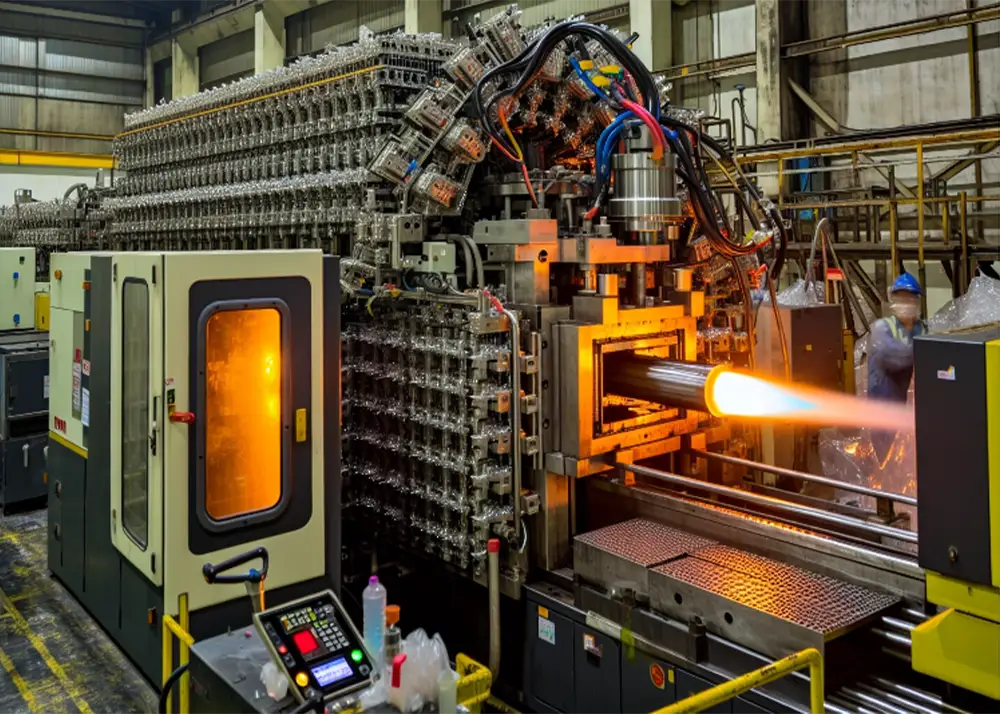
Advancements in Plastic Injection Molding Technology
In recent years, the injection molding industry has undergone significant transformations driven by advancements in technology. These advancements are focused on:
- Enhancing precision
- Miniaturization
- Material innovations
- Quality control
These advancements ultimately lead to improved efficiency and productivity in the manufacturing process.
We will further examine these advancements and their role in shaping the future of plastic injection molding.
Precision and Miniaturization in Plastic Injection Molding
The push for precision and miniaturization in injection molding has enabled the production of small, intricate components that are crucial for industries such as medical devices, electronics, and aerospace. Micro injection molding allows for the manufacturing of complex parts with a nearly negligible margin for error, catering to the growing demand for smaller components in various applications.
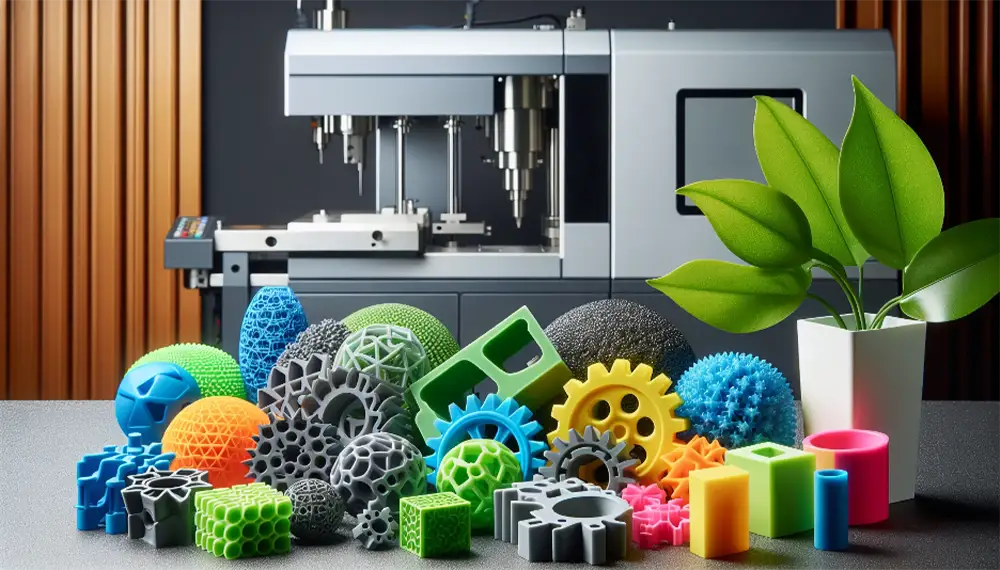
Material Innovations for Plastic Injection Molding
Material innovations have opened new doors in the world of injection molding with the development of eco-friendly, high-performance thermoplastics and composite materials. These cutting-edge materials offer enhanced mechanical properties, enabling manufacturers to create products with improved functionality and design.
The expansion of available materials allows injection molding to meet the changing demands of various industries and applications.
Quality Control in Plastic Injection Molding
Quality control is a vital element in the plastic injection molding process. The integration of advanced monitoring systems plays a vital role in ensuring consistent production and reducing defects in molded products. Lean manufacturing in plastic injection molding enhances this process by minimizing waste, improving efficiency, and optimizing resource utilization. Analyzing real-time data from the manufacturing process allows manufacturers to optimize the injection molding process, identify possible problems or deviations, and make immediate adjustments for efficient and accurate production.
In addition to real-time monitoring, predictive maintenance strategies have been adopted to enhance the performance and longevity of injection molding machines. By employing data analysis and machine learning algorithms, predictive maintenance systems can:
- Detect early signs of equipment failure or performance degradation
- Enable maintenance teams to schedule maintenance activities before a breakdown occurs
- Minimize unplanned downtime
- Optimize maintenance schedules
- Ensure that maintenance tasks are performed at the most opportune times
- Further, reduce downtime
This proactive approach helps to maximize the efficiency and productivity of injection molding operations by optimizing the performance of the injection unit.
Smart Factory Integration in Plastic Injection Molding
Smart factory integration is revolutionizing the plastic injection molding industry. By incorporating real-time monitoring systems, predictive maintenance strategies, and advanced robotics and automation, manufacturers can increase efficiency and reduce downtime, leading to a more streamlined and cost-effective production process.
The subsequent subsections will cover these innovative technologies and their effect on plastic injection molding.
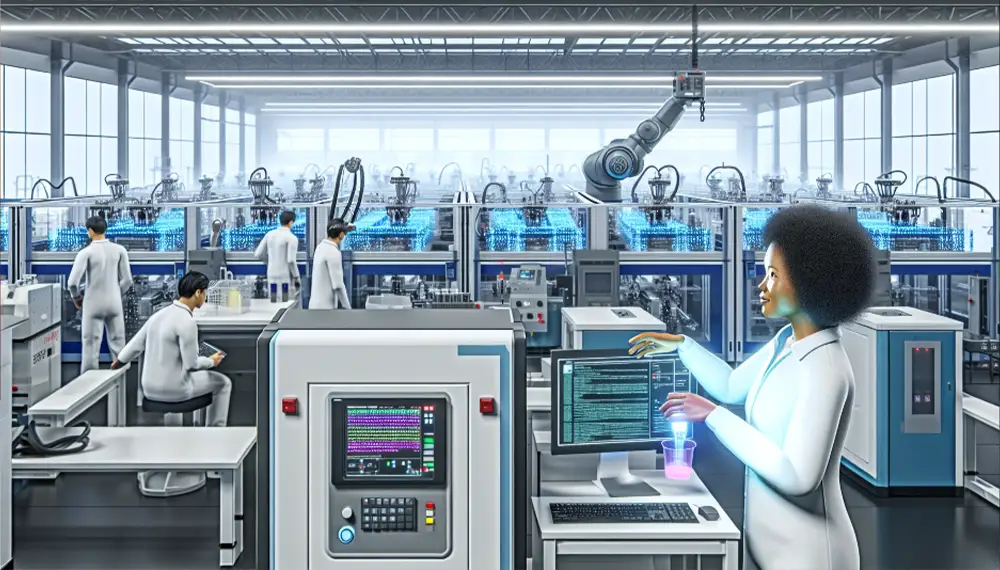
Plastic Injection Molding Machines | Real-Time Monitoring Systems
Real-time monitoring systems significantly improve the plastic injection molding process. By continuously tracking and analyzing essential process parameters such as temperature, injection pressure, and cycle time, these monitoring systems ensure consistent and efficient production while minimizing waste and maximizing productivity.
The most recent developments in real-time monitoring systems include the use of smart sensors, cloud-based software, and real-time production monitoring, providing manufacturers with valuable insights and control over the injection molding process.
Predictive Maintenance Strategies
Predictive maintenance strategies are becoming an important part of maintaining the performance and lifespan of plastic injection molding machines. By monitoring and analyzing historical data to identify common issues and determine maintenance intervals, manufacturers can optimize the performance of their machines and extend their lifespan. Moreover, the implementation of up-to-date systems to monitor the machine and anticipate failures further enhances the reliability and efficiency of the injection molding process.
The benefits of employing predictive maintenance strategies in plastic injection molding are numerous, including:
- Uninterrupted operation
- Enhanced efficiency
- Cost reduction
- Enhanced product quality
- A competitive edge
Staying proactive about equipment issues and scheduling maintenance activities ahead of time helps manufacturers minimize unexpected breakdowns and maximize the performance of their injection molding machines.
Enhanced Robotics and Automation
The integration of robotics and automation in plastic injection molding has brought about significant improvements in efficiency and productivity. By automating various aspects of the injection molding process, such as insert handling, part placement, and part removal, manufacturers can achieve faster production cycles, reduce the risk of errors, and increase overall output.
Moreover, advances in robotics technology have enabled the integration of sensors for precise part processing, further enhancing the accuracy and consistency of the manufacturing process.
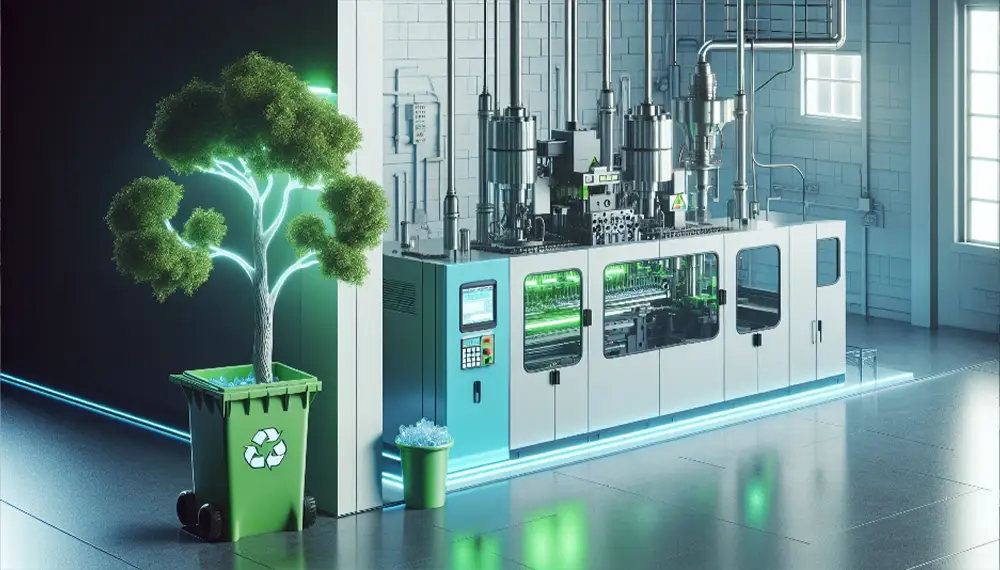
Green Molding: Sustainable Practices Taking Root
Green molding practices are gaining prominence in the plastic injection molding industry, with a focus on energy-efficient machines, recycling, and material reuse. By adopting these sustainable practices, manufacturers can reduce their environmental footprint and promote a more responsible approach to plastic production.
The subsequent subsections will cover various green molding practices and their influence on the industry.
Energy-Efficient Plastic Injection Molding Machines
Energy-efficient injection molding machines are designed with various technologies and features to minimize energy consumption during the molding process. These machines can achieve up to 80% greater energy savings compared to traditional machines, thanks to both the power and heating components of the machine, as well as the direct electrical drive in all-electric machines, which eliminates the need for additional power sources.
Lowering energy consumption makes energy-efficient injection molding machines a more sustainable and cost-effective manufacturing process.
Recycling and Material Reuse
Promoting sustainability in plastic injection molding requires recycling and material reuse practices. By breaking down post-industrial residue and returning it to the injection molding machine, manufacturers can recycle and reutilize plastic materials, thereby decreasing waste and promoting a more sustainable manufacturing process. Additionally, plastic pieces can be melted into pellets for reuse in the molding process, further reducing waste and conserving resources.
Despite the numerous benefits of recycling and material reuse, there are certain challenges associated with this practice in plastic injection molding. These challenges include:
- Contamination and impurities that could affect material performance
- The need to adjust temperature and screw speed when dealing with recycled materials
- Increased energy usage when the process is not optimized
- The importance of using recycled materials to minimize plastic waste
By addressing these challenges and embracing sustainable practices, manufacturers can contribute to a greener and more responsible plastic injection molding industry.
Plastic Injection Molding Quote | CBM Plastics USA
Enhancing Mold Design with Advanced Software
Advanced software tools play a crucial role in enhancing mold design, including the mold cavity, in plastic injection molding. By enabling simulation, optimization, and collaborative design platforms, as well as customization through additive manufacturing, these tools empower manufacturers to create better-quality products and optimize their production processes.
The subsequent subsections will cover various software tools and their applications in the plastic injection molding industry.
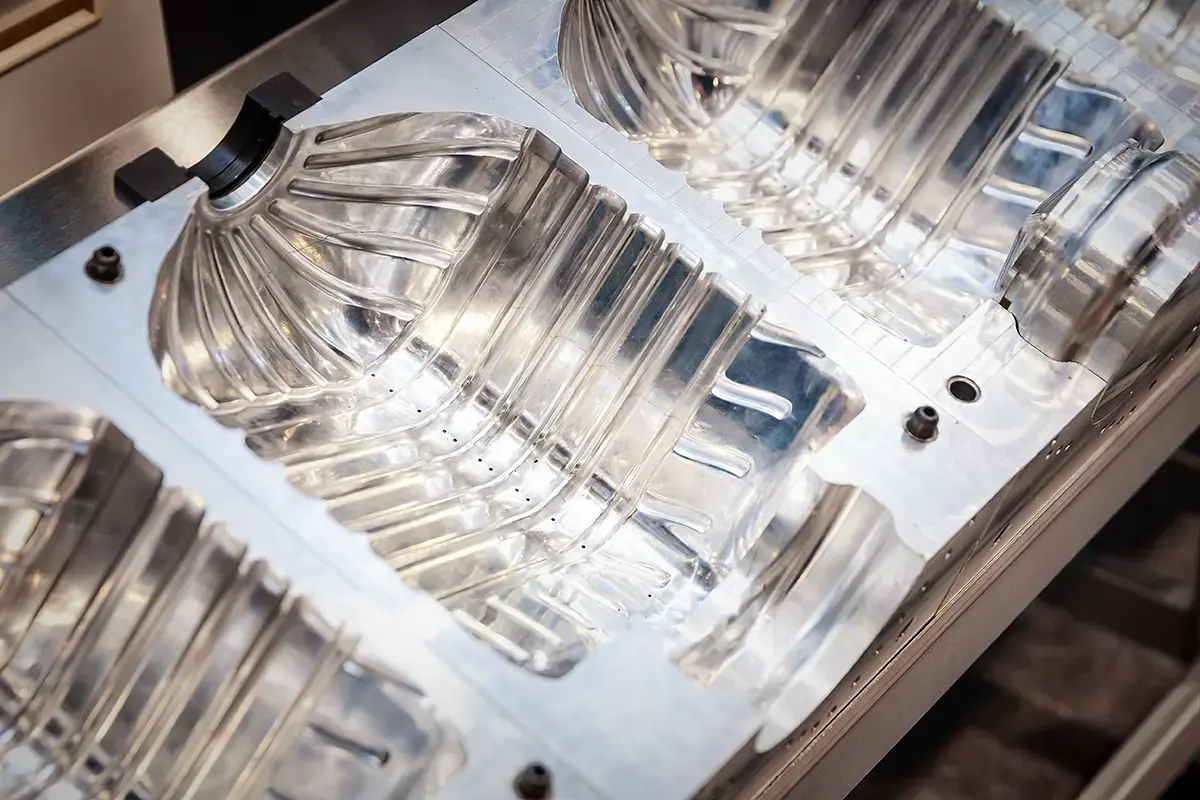
Simulation and Optimization Tools
Simulation software is now a critical tool in mold design for plastic injection molding. By enabling engineers to predict and analyze the molding process with accuracy, these tools help identify potential design issues, optimize mold construction, and make informed decisions to enhance the quality of the final product. Ultimately, simulation software helps avoid design issues, reduce rework and scrap, save time and cost, and optimize the manufacturing process.
Alongside simulation software, optimization tools are vital in cost reduction and efficiency improvement in plastic injection molding. By designing for efficiency, minimizing the risk and cost of quality, increasing efficiency through automation, and optimizing mold design, these tools can significantly impact the overall cost and success of the injection molding process. By harnessing the power of these cutting-edge software tools, manufacturers can revolutionize the way they approach mold design and plastic injection molding.
Collaborative Design Platforms
Collaborative design platforms have emerged as a significant innovation in the plastic injection molding industry. By facilitating communication and coordination between designers, engineers, and manufacturers, these platforms enable the sharing of design files, feedback, and revisions, as well as allowing for real-time collaboration among multiple stakeholders. This leads to more efficient and accurate mold designs, as well as reducing the time and cost of the overall mold design process.
Some of the leading collaborative design platforms used in plastic injection molding include Moldflow, Fictiv’s DFM for injection molding solutions, and CAE software for feedback and suggestions. These platforms not only streamline the design process but also provide valuable insights into the molding process, enabling manufacturers to optimize their production and enhance the quality of their products.
Customization Through Additive Manufacturing
Additive manufacturing, or 3D printing, has opened up new possibilities for customization in plastic injection molding. By enabling the creation of molds with complex geometries and conformal cooling systems, additive manufacturing increases the efficiency and quality of the injection molding process. Furthermore, it facilitates the production of molds tailored to specific designs, providing greater flexibility and adaptability in production.
By leveraging the capabilities of additive manufacturing, manufacturers can create customized and personalized plastic products that cater to the evolving demands of the market.
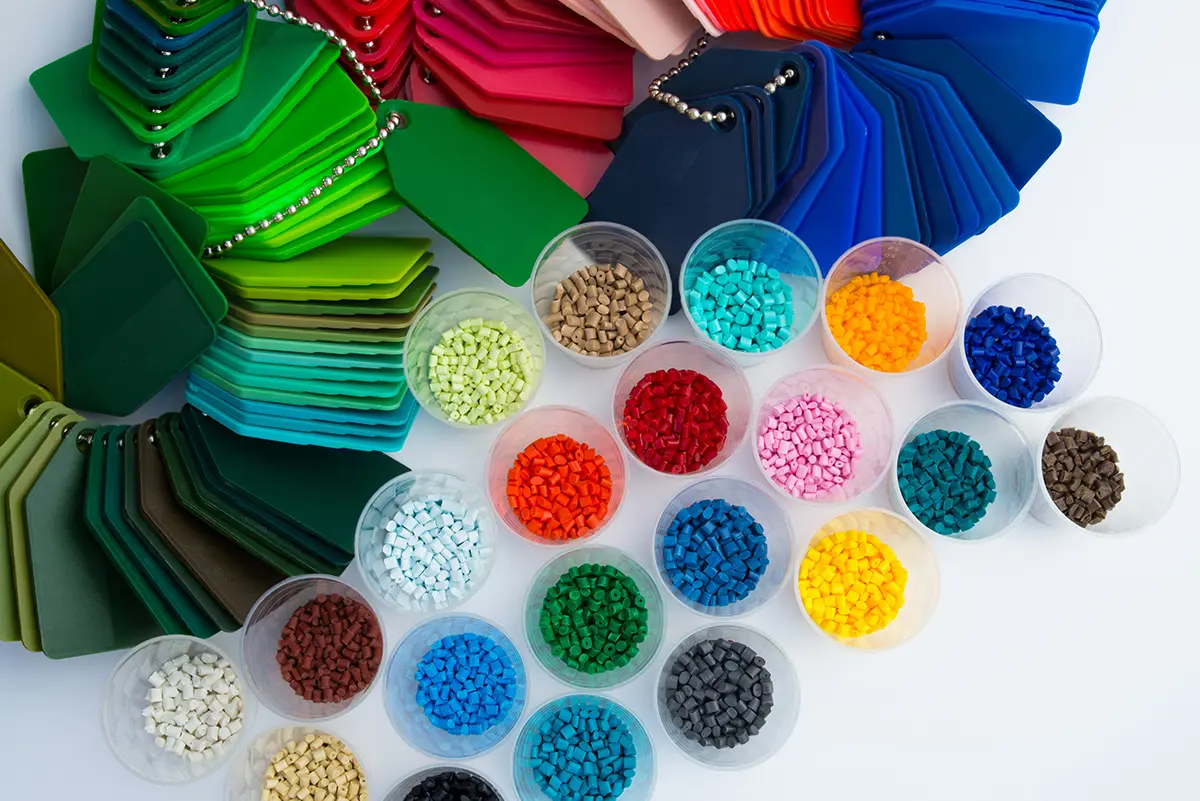
Cutting-Edge Materials: Exploring New Frontiers
The development of cutting-edge materials in plastic injection molding, including various plastic material options, has opened new frontiers in product design and functionality. From high-performance thermoplastics and composite materials to smart polymers, these innovative materials are transforming the way plastic products are designed and manufactured.
The subsequent subsections will cover these materials and their influence on the plastic injection molding industry.
High-Performance Thermoplastics
High-performance thermoplastics have significantly enhanced the strength and durability of injection-molded parts, making them suitable for applications where product failure is not an option. These thermoplastics are designed for long-term, repeated use, optimizing the injection process by reducing cycle times and increasing productivity.
Common applications for high-performance thermoplastics in injection molding include automotive parts, consumer electronics, medical devices, and household items.
Composite Materials
Composite materials in plastic injection molding refer to materials composed of a plastic resin combined with reinforcing fibers, such as carbon fibers or glass fibers, to enhance strength, stiffness, and other mechanical properties. The injection molding process is typically utilized to fabricate composite parts by injecting the heated composite material into a mold to achieve the desired shape.
The use of composite materials offers numerous benefits, including increased strength and durability, weight reduction, and design versatility.
Smart Polymers
Smart polymers are a class of materials that can modify their properties depending on the environment they are in. These polymers are increasingly being utilized in injection molding for applications requiring responsive and adaptive materials. By introducing smart polymers into the molding process, manufacturers can create products with enhanced durability, functionality, and performance.
The Rise of On-Demand Injection Molding
On-demand injection molding is revolutionizing the manufacturing landscape by allowing for flexible production schedules, cost-effective short runs, and customization and personalization of products. This approach caters to the evolving market demands and enables rapid turnaround times and cost-efficient production of customized plastic parts.
The subsequent subsections will cover various aspects of on-demand injection molding and its influence on the industry.
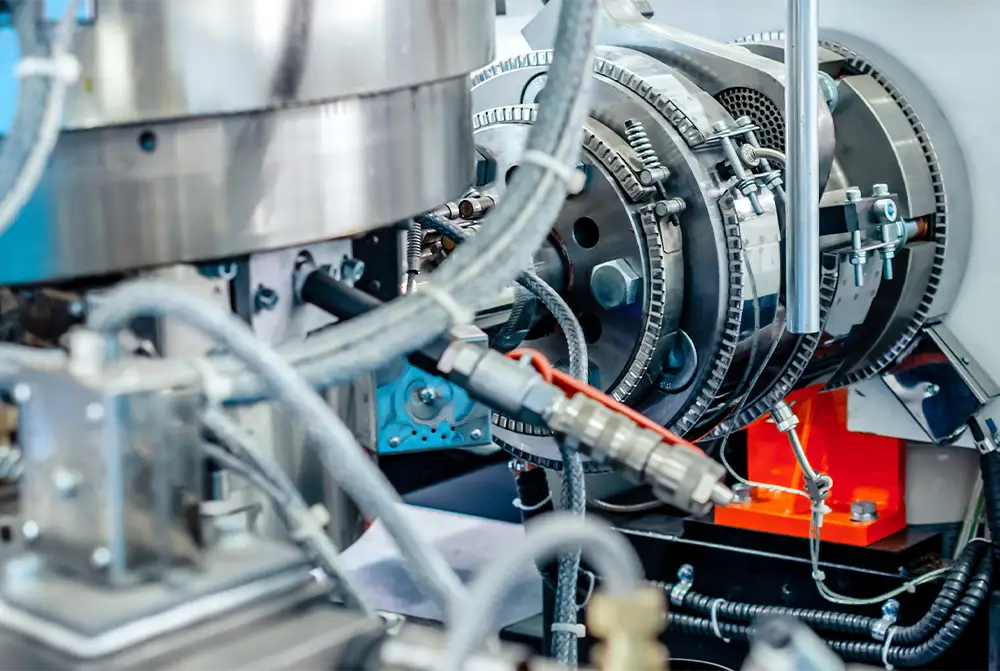
Flexible Production Schedules
Flexible production schedules in on-demand injection molding offer several advantages, including:
- Lower inventory costs
- More flexibility
- Increased customization
- Better sustainability
- Improved customer satisfaction
With the advent of Industry 4.0, the integration of advanced technologies and data-driven decision-making in the injection molding process has further enhanced the flexibility and adaptability of production schedules, ensuring that manufacturers can meet the ever-changing demands of their customers.
Customization and Personalization
On-demand injection molding enables manufacturers to meet the growing demand for customized and personalized products. By leveraging advanced manufacturing techniques, such as 3D printing and computer-aided design (CAD), manufacturers can create unique designs and specifications tailored to individual needs and preferences. As a result, customers can produce customized and personalized products in small quantities or even on an individual basis, leading to a more tailored and individualized end product.
The latest developments in on-demand injection molding have broadened the opportunities for customization and personalization. With the integration of advanced materials, such as high-performance thermoplastics and composite materials, manufacturers can create products with unique properties and functionalities that cater to specific applications and requirements. By staying ahead of the curve and embracing the latest innovations in on-demand injection molding, manufacturers can unlock new opportunities for growth and success in the plastic injection molding industry.
Cost-Effective Short Runs
On-demand injection molding offers several advantages for small-batch or low-volume manufacturing:
- Minimizes setup time required for each production run
- Enables faster production and turnaround times
- Allows for customization and flexibility in production
This approach is particularly efficient and economical for small-batch or low-volume manufacturing.
Reducing the need for large-scale production through on-demand injection molding and the use of injection molds helps manufacturers save on inventory, storage, and labor costs.
Contact CBM Plastics USA for your plastic injection molding quote.
Let us help you with a custom injection molding quote for your project.
Overcoming Challenges with Hybrid Molding Techniques
Hybrid molding techniques have transformed the plastic injection molding industry. They combine metal-to-plastic conversion, multi-material molding, and insert molding innovations to overcome manufacturing process challenges. These techniques offer versatile and high-quality products, catering to the diverse needs of various industries.
The subsequent subsections will cover these hybrid molding techniques and their influence on plastic injection molding in Illinois.
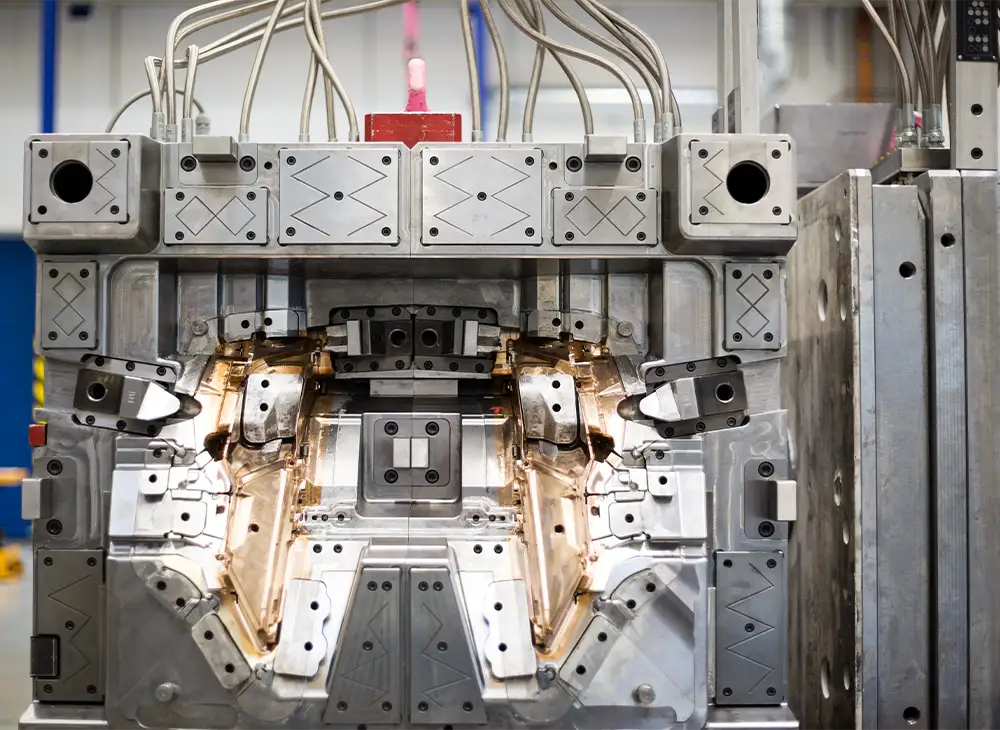
Metal to Plastic Conversion
Metal-to-plastic conversion in injection molding is a process of substituting metal components with engineered thermoplastics to achieve comparable tensile strength and reduced part weight. This conversion can significantly impact cost and efficiency, as molten plastic flows into components with increased speed and accuracy during the injection molding cycle compared to their metal counterparts. Utilizing a well-designed plastic injection mold is crucial for achieving these benefits.
Replacing metal parts with plastic allows manufacturers to achieve cost savings, design flexibility, and improve the performance of their products using plastic injection molds.
Insert Molding Innovations
Insert molding techniques have seen significant advancements in recent years, with the integration of preformed components, such as metal or plastic parts, into a single molded part. This process improves efficiency and reduces assembly time, as the insert is molded directly into the plastic component. Additionally, the use of additive manufacturing technologies, like 3D printing, is gaining popularity in the mold-making process, offering new possibilities for insert molding.
By incorporating these innovative insert molding techniques, manufacturers can improve product quality and efficiency, leading to enhanced performance and durability in the final product. As the plastic injection molding industry continues to evolve, manufacturers need to stay updated and adopt the latest advancements in hybrid molding techniques to meet the changing demands of their customers.
Multi-Material Molding
Multi-material molding is a technique that involves injecting two or more different materials into a mold to create a single finished product, such as double-shot injection molding or co-injection. This process allows manufacturers to combine materials with varying properties, such as plastics, metals, or non-plastics, to achieve desired characteristics or functionalities in the final product.
By employing multi-material molding, manufacturers can create innovative and complex products with enhanced properties and performance.
CBM Plastics: Innovators In Custom Plastic Injection Molding, Illinois
CBM Plastics, a renowned innovator in custom plastic injection molding based in Illinois, has been at the forefront of embracing these cutting-edge advancements in the industry. As a full-service plastic injection molding contract manufacturer, CBM Plastics offers a comprehensive suite of mold-making and production services, including:
- Consultation
- Mold design and engineering
- Prototype development
- Production molding
- Assembly and finishing
- Product Distribution
Staying updated and adopting the latest innovations in plastic injection molding allows CBM Plastics to provide its customers with high-quality products that meet their specific needs and preferences.
Contacting CBM Plastics
If you’re interested in learning more about the innovative solutions CBM Plastics offers or if you have specific needs for your next project, the team at CBM Plastics would be more than happy to assist. You can reach out to them through their Contact Page.
Plastic Injection Molding Innovations Summary
In conclusion, the plastic injection molding industry has witnessed remarkable innovations that are revolutionizing manufacturing processes and enabling the production of high-quality, customized products. From precision and miniaturization to smart factory integration and sustainable practices, these advancements are unlocking new frontiers in product design, functionality, and sustainability. As the industry continues to evolve, manufacturers must stay informed and adopt the latest technologies and practices to ensure they remain competitive and deliver the best possible products to their customers.
Contact CBM Plastics USA for your plastic injection molding quote.
Let us help you with a custom injection molding quote for your project.
Frequently Asked Questions
Additive Technology and Digital Manufacturing Direct Metal Laser Sintering (DMLS) is the latest technology in injection molding, using metal 3D printing to create molds that are difficult or impossible to achieve with traditional methods.
Injection molding is transforming with the introduction of Industry 4.0 and increased interest in IoT, AI, and Big Data. This points to an optimistic future for the industry.
Injection molding is a process that involves melting plastic materials, injecting them into a mold and then cooling and solidifying them into a desired shape. It is a great way to mass-produce products with complicated shapes and is widely used in the plastic processing industry.
Real-time monitoring systems improve the plastic injection molding process by continuously tracking and analyzing parameters, leading to improved efficiency, minimal waste, and increased productivity.
Additive manufacturing enables the creation of molds with complex geometries and conformal cooling systems, allowing for greater customization during plastic injection molding and the production of tailored designs.
For More Frequently Asked Questions About Custom Plastic Injection Molding Check Out This Comprehensive Resource.

